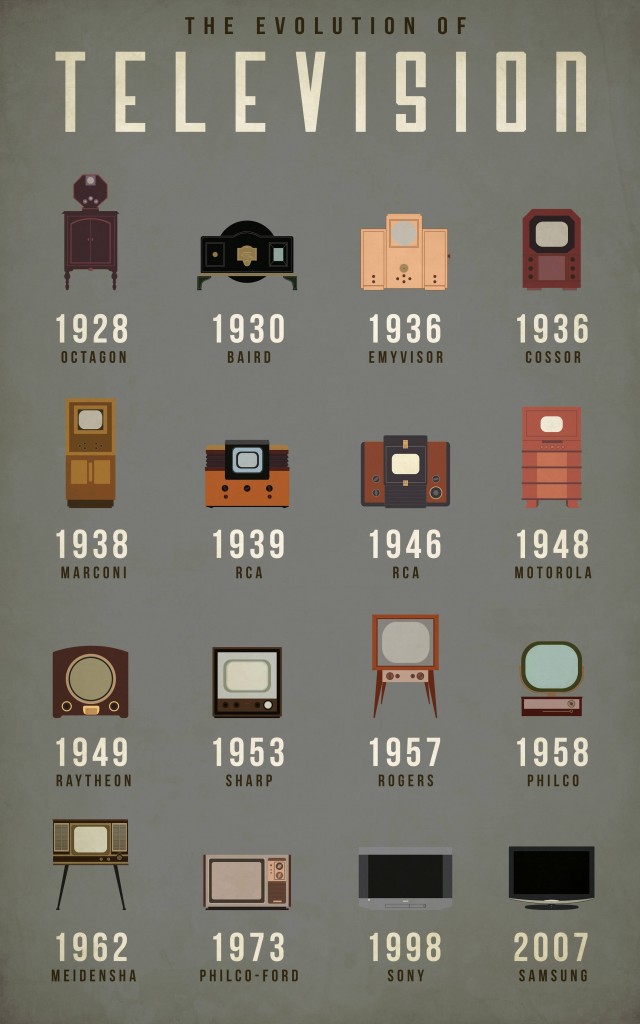Discussion Question Response to Screens: Television’s Dispersed ‘Broadcast’
- Could one argue that with the emergence of digitalized media, the face of television, as we know it, is subject to change into an entity (thing with distinct creation) entirely different than what people are familiar with? In what possible ways could this potential change impact society?

Image Credit: fastcodesign
I believe we live in a culture where everything seems to be going faster and faster, and the evolution of television is no exception. With the emergence of digitalized media, television consumption has become, not only faster, but also more individualized and customized. This is the opposite of where television first began. The way television is evolving reminds me of how handwritten letters have grown into email and text messages – another example of the technology boom and its impact. While the format is the same (one person sends a message, the recipient replies), the ways we receive those messages are completely different today. The perception and opinion of handwritten letters have changed – the act now holds a more sentimental value rather than for just purely communication. I think the same is happening to television; a family sitting together to watch one television screen with very limited channel options has now gained an affectionate, almost nostalgic, feel. In “Screens: Television’s Dispersed Broadcast,’” Marshall explains how television utilized a paternalistic form of delivery in that “content was pushed at the viewer, and the viewer accepted the pleasures of the flow.” The pleasures of the flow became summarized as “watching television” where mentioning the specific program was not necessary. I see this same feeling similar with Netflix today; “watching Netflix” has a similar meaning of enjoying the experience without having to specify whatever program explicitly.
While we still feel that pleasure of flow and television is still just a moving image, the way we receive that image has rapidly changed. As television grows in choices, so does the individualization and customization. With cable or satellite, many channels are included with the package that people may or may not watch (either way, you’re paying for them). Looking at DVDs from today, they almost seem like they were more of a trend – they almost feel obsolete now, in my opinion, yet changed television in large ways. It’s important to note that DVDs brought a new layer to television consumption – portability.
With home DVD players, subsequent production moved to making the players portable – now with laptops, iPads, tablets, and even cell phones, television can reside on a smaller screen. A combination of portability and streaming (and a good Wi-Fi connection) gives the audience complete control over choosing what to watch whenever and wherever.
Another detail to note is that DVD changed a key characteristic of television. Television has a distinct episodic format that has the audience waiting for the next development of the plotline during the episode itself and between each episode. Of course, those breaks during the television episodes show allowed for dispersed advertising. Now with streaming and pre-recording, there’s no longer fixed eyes on the television screen to see those advertisements. Instead, those eyes fast forward through the commercials or skip them altogether (although, the streaming site Hulu does include interspersed advertising). The ability of streaming and downloading multiple episodes of a television series has not only broken away from dispersed advertising, but has define a culture of “binge-watching” where the audience watches the television episodes for long amounts of time with no break in-between each episode.
Overall, television is the same moving image, but with an increasingly individualized and customized way of getting that image. The ability to stream television contributes to the fast-pace of society and makes television much more portable and accessible for the individual consumption. As of right now, I don’t believe digitalized media and streaming has progressed television into a completely different entity, but once live events (such as news or sporting events) can be streamed seamlessly and directly, I think that’s when the way of traditional television may end and a new era could be ushered in.